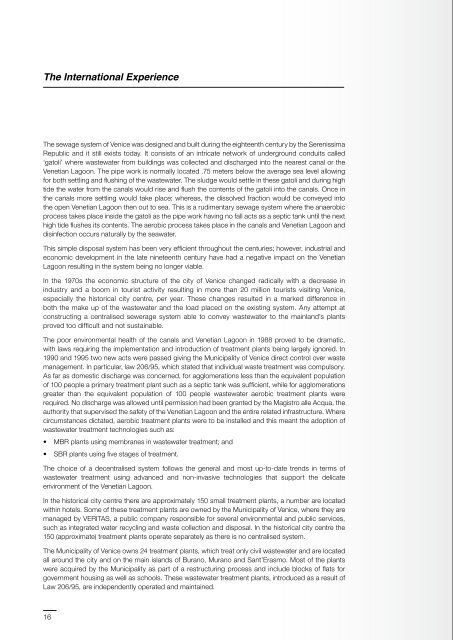Wastewater Treatment: Remote Control and Monitoring
Wastewater Treatment: Remote Control and Monitoring
Wastewater Treatment: Remote Control and Monitoring
Create successful ePaper yourself
Turn your PDF publications into a flip-book with our unique Google optimized e-Paper software.
The International ExperienceThe International ExperienceThe sewage system of Venice was designed <strong>and</strong> built during the eighteenth century by the SerenissimaRepublic <strong>and</strong> it still exists today. It consists of an intricate network of underground conduits called‘gatoli’ where wastewater from buildings was collected <strong>and</strong> discharged into the nearest canal or theVenetian Lagoon. The pipe work is normally located .75 meters below the average sea level allowingfor both settling <strong>and</strong> flushing of the wastewater. The sludge would settle in these gatoli <strong>and</strong> during hightide the water from the canals would rise <strong>and</strong> flush the contents of the gatoli into the canals. Once inthe canals more settling would take place; whereas, the dissolved fraction would be conveyed intothe open Venetian Lagoon then out to sea. This is a rudimentary sewage system where the anaerobicprocess takes place inside the gatoli as the pipe work having no fall acts as a septic tank until the nexthigh tide flushes its contents. The aerobic process takes place in the canals <strong>and</strong> Venetian Lagoon <strong>and</strong>disinfection occurs naturally by the seawater.This simple disposal system has been very efficient throughout the centuries; however, industrial <strong>and</strong>economic development in the late nineteenth century have had a negative impact on the VenetianLagoon resulting in the system being no longer viable.In the 1970s the economic structure of the city of Venice changed radically with a decrease inindustry <strong>and</strong> a boom in tourist activity resulting in more than 20 million tourists visiting Venice,especially the historical city centre, per year. These changes resulted in a marked difference inboth the make up of the wastewater <strong>and</strong> the load placed on the existing system. Any attempt atconstructing a centralised sewerage system able to convey wastewater to the mainl<strong>and</strong>’s plantsproved too difficult <strong>and</strong> not sustainable.The poor environmental health of the canals <strong>and</strong> Venetian Lagoon in 1988 proved to be dramatic,with laws requiring the implementation <strong>and</strong> introduction of treatment plants being largely ignored. In1990 <strong>and</strong> 1995 two new acts were passed giving the Municipality of Venice direct control over wastemanagement. In particular, law 206/95, which stated that individual waste treatment was compulsory.As far as domestic discharge was concerned, for agglomerations less than the equivalent populationof 100 people a primary treatment plant such as a septic tank was sufficient, while for agglomerationsgreater than the equivalent population of 100 people wastewater aerobic treatment plants wererequired. No discharge was allowed until permission had been granted by the Magistro alle Acqua, theauthority that supervised the safety of the Venetian Lagoon <strong>and</strong> the entire related infrastructure. Wherecircumstances dictated, aerobic treatment plants were to be installed <strong>and</strong> this meant the adoption ofwastewater treatment technologies such as:• MBR plants using membranes in wastewater treatment; <strong>and</strong>• SBR plants using five stages of treatment.The choice of a decentralised system follows the general <strong>and</strong> most up-to-date trends in terms ofwastewater treatment using advanced <strong>and</strong> non-invasive technologies that support the delicateenvironment of the Venetian Lagoon.In the historical city centre there are approximately 150 small treatment plants, a number are locatedwithin hotels. Some of these treatment plants are owned by the Municipality of Venice, where they aremanaged by VERITAS, a public company responsible for several environmental <strong>and</strong> public services,such as integrated water recycling <strong>and</strong> waste collection <strong>and</strong> disposal. In the historical city centre the150 (approximate) treatment plants operate separately as there is no centralised system.Public Aerobic Plants in the City of Venice 9The decision whether to build a SBR or a MBR plant is solely determined by the space available at theproposed location:• SBRs operate using five steps:1. Filling2. Mixing3. Aerobic reaction4. Settling <strong>and</strong> drawing5. Discharge into the Venetian Lagoon.• MBRs operate by combining the activated sludge treatment together with a separation of thebiological sludge by an ultra-filtration membrane in order to produce a particle free effluent.Twenty years after Italy’s unique historical city of Venice was listed as a World Heritage Site it hasbecome the centre of an equally unique development of modern technology in which a centralisedcontrol system manages the operation of 100 small decentralised wastewater treatment plants.The Municipality of Venice owns 24 treatment plants, which treat only civil wastewater <strong>and</strong> are locatedall around the city <strong>and</strong> on the main isl<strong>and</strong>s of Burano, Murano <strong>and</strong> Sant’Erasmo. Most of the plantswere acquired by the Municipality as part of a restructuring process <strong>and</strong> include blocks of flats forgovernment housing as well as schools. These wastewater treatment plants, introduced as a result ofLaw 206/95, are independently operated <strong>and</strong> maintained.1617
















